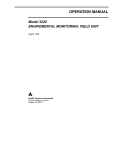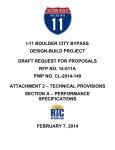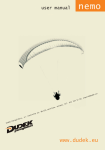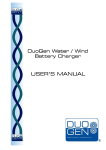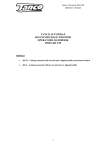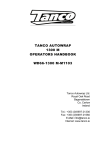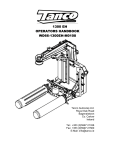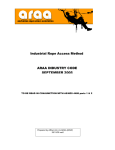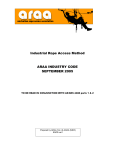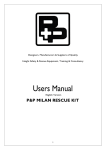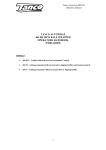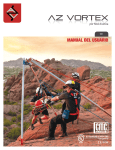Download MPD User`s Manual
Transcript
USER’S MANUAL V2.2 6740 Cortona Drive Goleta, CA 93117 USA [email protected] MULTI-PURPOSE DEVICE (800) 235-5741 cmcrescue.com Pulley l Descent Control l Belay 3330X0.00.101413 5. Let go of Release Handle immediately to activate belay! M/A System 1. 2. 3. 4. 5. Rig running end of rope through additional pulley(s). Attach moving pulley to rope with rope grab. Unlock Parking Brake. Pull rope through M/A system. MPD will hold rope during reset. MULTI-PURPOSE DEVICE USER’S V2.2 MANUAL Pulley l Descent Control l Belay Thank you for selecting the CMC Rescue MPD™ for your technical rope rescue systems. Truly a multi-purpose device, the flexibility and versatility of the MPD reduces the number of components in a rescue system and simplifies system rigging. The result is a safer and more efficient rescue. Please contact Customer Support if you have questions about this, or any other CMC Rescue product. WARNING ° Serious injury or death may result from the improper use of this equipment. ° This equipment has been designed and manufactured for use by experienced professionals only. ° Do not attempt to use this equipment without proper training. ° Failure to follow these instructions could result in serious injury or death. THIS DEVICE MEETS THE AUXILIARY EQUIPMENT (PULLEY, DESCENT CONTROL AND BELAY DEVICE) REQUIREMENTS OF NFPA 1983, STANDARD ON LIFE SAFETY ROPE AND EQUIPMENT FOR EMERGENCY SERVICES, 2012 EDITION. EMERGENCY SERVICES AUXILIARY EQUIPMENT IN ACCORDANCE WITH NFPA 1983-2012. THIS MPD HAS PASSED THE MINIMUM BREAKING STRENGTH AND HOLDING LOAD TEST USING THE FOLLOWING ROPE: NEW ENGLAND ROPES, KMIII, CMC ITEM K05160, 13 mm OR NEW ENGLAND ROPES, KMIII, CMC ITEM K05140, 11 mm (AS APPLICABLE). About the MPD 2 Release Handle 2 Parking Brake 4 Rigging the MPD 4 Securing the MPD 7 Using the MPD as a Descent Control Device 8 To Lower 8 To Stop Lowering 11 Using the MPD as a Belay Device 12 Belaying a Lowering System 12 Belaying a Raising System 15 Mirrored Systems 15 Using the MPD in a Mechanical Advantage System 16 Additional Information 17 (KMIII rope used for certification. For information on performance with other life safety ropes, please contact CMC Rescue). High Lines and Guiding Lines 17 Care and Maintenance 17 MADE IN THE USA (of US and foreign components). Inspection and Repair 18 The most current version of the MPD User’s Manual can be downloaded at cmcrescue.com/mpd. Specifications 19 Quick Reference Guide 20 ISO 9001: 2008 Certified ©2013 CMC Rescue, Inc. All Rights Reserved. 1 CMC Rescue, Inc. 6740 Cortona Drive, Goleta, CA 93117 USA (800) 235-5741 or (805) 562-9120 [email protected] cmcrescue.com 2 THE MPD The MPD is designed for use with static or low-stretch kernmantle life safety rope. Use only rope that has been inspected, is of proper size and is in good condition. The user should be aware that environmental conditions may have an effect on the rope’s interaction with the MPD. For example, water saturated ropes, icy ropes or ropes otherwise covered with substances such as clay, tar or oil will, to varying extents, affect the rope’s interaction with the MPD. The user should be aware of these conditions and make necessary adjustments, such as adding additional friction. Saturated ropes or ropes covered with foreign material may not progress smoothly through the MPD, possibly resulting in a ratcheting type of progression as the rope moves through the device. Additionally, rope that is dirty, sandy or muddy may cause increased wear to the fixed and moving brakes, which may reduce the device’s ability to arrest and hold a load. RELEASE HANDLE The Release Handle is used to rotate the Moving Brake off of the rope, allowing rope movement through the device for lowering a load or releasing tension on a line, such as with a guiding line or track line. Pulling the Release Handle out engages a set of gears connected to the Moving Brake. To minimize wear on the Moving Brake, it is recommended to turn the handle fully counterclockwise to completely unseat the Moving Brake from the rope and to control the rate primarily with friction of the rope applied against the Fixed Brake V-Groove. To stop lowering and lock the rope, disengage the Release Handle. NOTE Although there is a return spring to assist in disengaging the Release Handle, it is the user’s responsibility to ensure that the handle is fully pushed in when not actively lowering. ! IF AT ANY TIME YOU NOTICE A SUDDEN CHANGE IN SPEED OR TENSION ON THE ROPE RUNNING THROUGH THE MPD, IMMEDIATELY LET GO OF THE RELEASE HANDLE (DISENGAGE) TO STOP THE LOAD! Item Number 333000, 13 mm Rope Model As with all new rescue equipment, the MPD should be thoroughly inspected before being placed in service. The MPD is a robust unit but should still be inspected after each use to ensure that damage did not occur. When inspecting, look for any damaged, dirty or sticking components, excessive wear or any other factor that may prevent proper function. Front Plate Secondary Friction Post Front Cover Parking Brake Release Handle Back Plate Becket High-Efficiency Pulley with One-Way Bearing Fixed Brake with V-Groove Moving Brake 3 Single Pulley Double Pulley Simple 3:1 M/A System Simple 5:1 M/A System ABOUT THE MPD 4 PARKING BRAKE A unique feature of the MPD is the Parking Brake, which when locked, prevents inadvertent letting out of the rope. The design of the Parking Brake allows for rope to be taken in if required without having to unlock it, although increased rope friction will be encountered. Lock the Parking Brake prior to releasing your grip from the running end of the rope, except when the MPD is rigged as a ratchet or progress capture in a pulley system. For example, once the rigged MPD is connected to the anchor, for safety, lock the Parking Brake until you are ready to use the device. To fully lock the Parking Brake when using untensioned, icy or saturated rope, it may first be necessary to pull out the Release Handle and rotate it clockwise to further force the Moving Brake against the rope. 1 REVIEW DIAGRAM FOR PROPER LOADING 2 ROTATE BACK PLATE FULLY OPEN Anchor THE MPD To rig the MPD, first ensure that the Parking Brake is unlocked. Hold the MPD so that the back plate faces up. Take note of the diagram showing the proper rope orientation, then open the MPD by rotating the back plate clockwise until there is sufficient space to insert the rope between the fixed and moving friction brakes. Insert the rope with the running end between the friction brakes and place the rope around the pulley in a clockwise direction. The load end of the rope exits the pulley opposite the friction brakes. Close the MPD by rotating the back plate completely counterclockwise, making sure that the rope properly enters and exits the MPD as shown in the diagram on the back plate. Attach the MPD to the anchor using an appropriate locking carabiner or screw link through both the front and back plates. INFORMATION HIGH LINES AND GUIDING LINES Running End Running End Load End Load End 3 INSERT ROPE Parking Brake must be unlocked to load. 4 CLOSE AND SECURE BACK PLATE 5 a fixed position of the friction hand, while the other hand feeds rope into the MPD. ! Feed In Running End FIRMLY GRIP RUNNING END OF ROPE TO ACTIVATE BELAY. RIGGING THE MPD 6 THE MPD ! NOTE The Parking Brake is intended to temporarily secure the MPD when it is necessary for the operator to release their grip on the running end of the rope. ALWAYS PERFORM A SAFETY CHECK BY UNLOCKING THE PARKING BRAKE AND GIVING A QUICK TUG ON THE LOAD END OF THE ROPE TO ENSURE PROPER RIGGING PRIOR TO COMMITTING A LIVE LOAD OVER AN EDGE. If the MPD is to be left unattended, or if you need to release your grip on the running end of the rope for more than a short time, lock the Parking Brake first and then secure the MPD by tying off the running end of the rope around the load end with an appropriate tie-off method. WHEN RIGGED PROPERLY, THE MPD WILL LOCK UP. THE MPD MUST BE PROPERLY RIGGED PRIOR TO USE. Tug on Load End Running End 7 BELAYING A RAISING SYSTEM If the load is being raised, then the Belay Line can simply be pulled hand over hand through the MPD. However, if the distance the load has to be raised is greater than approximately 30 m (100 ft), it is recommended to convert the Belay Line system into a simple 3:1 mechanical advantage properly disposed of after the operation is safely completed. BELAYING A LOWERING SYSTEM When belaying a lowering system, once the rescuer has good control of the load and is in the correct descent path (this often occurs within the first 8 AS A DESCENT CONTROL DEVICE When used to control a descent, the MPD design allows for easy adjustment of the friction for the size of the load, rope type, and environmental and terrain conditions. The speed of the descent is controlled by the friction of the rope applied against the Fixed Brake V-Groove. Always start with the running end held firmly back toward the anchor, parallel to the load end. Reduce the friction by varying the angle at which the running end enters the MPD. Maximum friction is applied when the Secondary Friction Post is used. ! Begin lowering by rotating the handle slowly counterclockwise all the way to completely unseat the Moving Brake from the rope, controlling the rate primarily with friction on the Fixed Brake V-Groove. Maintaining the “S-shaped” bend in the rope will improve the function of the braking mechanism in the event it is needed and will increase the service life of the Moving Brake, reducing the potential for rope creep through the device. AT NO POINT SHOULD THE RUNNING END OF THE ROPE HAVE AN ANGLE OF LESS THAN 90º TO THE LOAD END OF THE ROPE. S-shaped bend Edge transitions can be the most challenging part of an operation. Using the MPD as a descent control device allows for a high degree of responsiveness and control. As the rescuer or rescuer and patient approach the edge, it is very easy to take in rope through the MPD to prepare for the edge transition. Pretensioning of the Main Line is also simplified because of this. Anchor TO LOWER To lower, firmly grip the running end of the rope and tightly hold it against the Fixed Brake V-Groove, bringing it back toward the anchor and parallel to the load end, creating an “S-shaped” bend in the rope as it passes through the MPD. Pass the rope over the Secondary Friction Post for heavier loads if needed. Unlock the Parking Brake and then firmly grip the Release Handle. For the most comfortable hand operating position, before pulling outward on the handle, give a slight clockwise turn of the wrist, then pull out to engage the release mechanism. Load ! ALWAYS MAINTAIN A FIRM GRIP ON THE RUNNING END OF THE ROPE DIRECTED BACK TOWARD THE ANCHOR IN AN “S-SHAPED” BEND BEFORE ENGAGING THE RELEASE HANDLE. 9 10 m [33 ft] of the descent), it is recommended to convert from hand-tight Belay Line tension to shared tension between the Main Line and Belay Line. Should the Main Line system fail from this point on, a Shared Tension system will minimize rope stretch and provide a considerably reduced arresting distance as compared to a conventional untensioned belay. It engage the release mechanism (2) Rotate counterclockwise to lower USING THE MPD AS A DESCENT CONTROL DEVICE 10 FOR HEAVY LOADS Add additional friction by threading the rope over the Secondary Friction Post. PREPARING TO LOWER Firmly grip the running end of the rope and apply friction over the Fixed Brake V-Groove, bringing the rope back toward the anchor and parallel to the load end, creating an “S-shaped” bend in the rope. Load Load ALWAYS MAINTAIN AN “S-SHAPED” BEND IN ROPE TO STOP LOWERING TO LOWER To stop lowering and lock the rope, disengage the Release Handle. Unlock the Parking Brake. Grasp the Release Handle and pull up to engage the release mechanism (1) and then rotate counterclockwise to lower (2). Rotating the Moving Brake off the rope may significantly increase the service life of the MPD. NOTE Although there is a return spring to assist in disengaging the Release Handle, it is the user’s responsibility to ensure that the handle is fully pushed in when not actively lowering. (1) ! ALWAYS MAINTAIN A FIRM GRIP ON THE RUNNING END OF THE ROPE WHEN THE PARKING BRAKE IS NOT LOCKED. Pull up to engage the release mechanism (2) Rotate counterclockwise to lower FOR HEAVY LOADS Add additional friction by threading the rope over the Secondary Friction Post. 11 For the most comfortable hand operating position, before pulling outward on the handle, give a slight clockwise turn of the wrist, then pull out to engage the release mechanism. 12 AS A BELAY DEVICE The MPD is designed to be used as a belay device to arrest a falling load should the Main Line system fail. It is recommended that during edge transitions, while either lowering or raising loads, that the Belay Line tension be kept hand tight and without slack in the line. Stumbles by the rescuer or litter tender(s) are most likely to occur during edge transitions, which may result in the ropes being run across edges that can potentially damage or cut them. It is less likely to damage both ropes if the Belay Line remains untensioned during these transitions. Additionally, greater descent control can be achieved if only one rope manages the rate of descent during edge transitions. If the Main Line system completely fails during an edge transition (e.g. anchor failure or improper system connection), and if both ropes are suspended above the terrain, as when using a high directional, then a dynamic fall onto the Belay Line is likely. Among rescuers, this is widely recognized as potentially the worst case dynamic event in rescue work. While every effort should be made to rig and operate systems to minimize the potential for such dynamic events, the MPD is designed and has been tested to arrest a 1 m fall onto 3 m of static rope with a rescue-sized load and limit the peak force below 15 kN (3,372 lbf) with no more than 1 m (3.3 ft) stopping distance (as advocated by the British Columbia Council of Technical Rescue Belay Competency Drop Test Criteria). Such a dynamic event is severe and warrants that all involved equipment be retired and properly disposed of after the operation is safely completed. 10 m [33 ft] of the descent), it is recommended to convert from hand-tight Belay Line tension to shared tension between the Main Line and Belay Line. Should the Main Line system fail from this point on, a Shared Tension system will minimize rope stretch and provide a considerably reduced arresting distance as compared to a conventional untensioned belay. It will also help mitigate other hazards, such as an inadvertently slack Belay Line or rope-induced rockfall, since the now-tensioned Belay Line will be suspended above the terrain between contact points, just like the Main Line. SHARED TENSION SYSTEMS Shared Tension Systems are essentially two lowering systems in place of one lowering system and a belay, with each line supporting approximately half the load. If either system should fail, the increased load on the other descent control device will cause an increase in rate of descent. While the MPD is an effective belay device capable of safely arresting a falling load, when used as a descent control device you are manually overriding the belay function. This could result in increased stopping distances if not using proper technique. Therefore, in a Shared Tension lower it is imperative that the running end rope of the Belay Line be held back toward the anchor, maintaining the “S-shaped” bend as the rope runs through the MPD. If there is a sudden change in speed or tension on the rope running through the MPD, the belayer must immediately let go of the Release Handle (disengage) while maintaining a firm grip on the running end of the rope to ensure the braking mechanism activates and arrests the load in the shortest distance possible. ! YOU MUST LET GO OF THE RELEASE HANDLE WHILE MAINTAINING A FIRM GRIP ON THE RUNNING END OF THE ROPE TO ACTIVATE THE BELAY! BELAYING A LOWERING SYSTEM When belaying a lowering system, once the rescuer has good control of the load and is in the correct descent path (this often occurs within the first 13 Begin lowering by rotating the handle slowly counterclockwise all the way to completely unseat the Moving Brake from the rope, controlling the rate primarily with friction on the Fixed Brake V-Groove. Maintaining the “S-shaped” bend in the rope will improve the function of the braking mechanism in the event it is needed and will increase the service life of Running End USING THE MPD AS A BELAY DEVICE 14 For the greatest system redundancy and therefore safety ensure the Belay Line system is anchored and operated independently of the Main Line system. As with the Main Line, it is recommended that someone assist the Belay Line operator by feeding rope to ensure there are no tangles or snags that would cause the operator to unnecessarily stop the operation. BELAYING THE EDGE TRANSITION To ensure proper hand-tight tension of the Belay Line (such as during edge transitions), firmly grip the load end of the rope with one hand and apply friction, so that there is no slack in the rope between the load and your hand. The other hand feeds the running end into the MPD so that the rope is unseated from the sheave tread. This will reduce rope drag on the sheave and keep the MPD from inadvertently locking up. This technique allows the operator to match the speed of the Main Line. In contrast, the technique of trying to simultaneously shuffle rope into and out of the MPD will result in a repetitious start-stop motion of the belay rope and will likely result in frequent unwanted lockups. Applying Hand-Tight Tension to the Belay Line The operator is bracing his arm on his leg to help maintain a fixed position of the friction hand, while the other hand feeds rope into the MPD. ! Load NOTE The Parking Brake is intended to If the load is being raised, then the Belay Line can simply be pulled hand over hand through the MPD. However, if the distance the load has to be raised is greater than approximately 30 m (100 ft), it is recommended to convert the Belay Line system into a simple 3:1 mechanical advantage pulley system to assist with the raising of the load. The load can be raised more efficiently if the Belay Line assists with the raising, since it is possible that a lower mechanical advantage will be required by the Main Line. This will also take the stretch out of the line. For the final edge transition, convert back to a 1:1 system using only hand tight tension on the Belay Line by pulling it hand over hand through the MPD. MIRRORED SYSTEMS Rope rescue systems, where both rope systems are capable of simultaneously performing as a Main Line and a Belay Line are referred to as Mirrored Systems. Unlike the MPD, most descent control devices are incapable of performing both functions concurrently. Ideally, a true independent Mirrored System is achieved with maximum flexibility and versatility when both the Main Line and Belay Line are each managed with an MPD. This way either rope system can perform either function, without the need for complex changeovers or function specific equipment. Additionally, if an MPD is used for both the Main Line and Belay Line in a Shared Tension System, then should either of these systems fail, the other rope system can serve as a belay and the potential arresting distance is minimized since both ropes will be prestretched. Feed In Running End FIRMLY GRIP RUNNING END OF ROPE TO ACTIVATE BELAY. THE MPD BELAYING A RAISING SYSTEM 15 the rope around the pulley in a clockwise direction. The load end of the rope exits the pulley opposite the friction brakes. Close the MPD by rotating the back plate completely counterclockwise, making sure that the rope properly enters and exits the MPD as shown in the diagram on the back plate. Attach the MPD to the anchor using an appropriate locking carabiner or screw link through both the front and back plates. 16 IN A MECHANICAL ADVANTAGE SYSTEM The MPD is designed to function both as a pulley and as a ratchet or progress capture device in a M/A system. After lowering, there is no need for a complex changeover between a lowering system and a raising system. The one-way pulley inside the MPD applies friction during descent control but serves as a fully functional, high-efficiency pulley while raising the load. The MPD effectively locks the rope during pulley system resets with minimal settling in distance. To convert to an M/A system, simply attach a rope grab and traveling pulley to the Main Line and a simple 3:1 mechanical advantage is created. The MPD has a built in Becket that can be used to attach a change of direction pulley to allow higher mechanical advantage systems to be built (e.g. simple 5:1 or compound 9:1), thereby eliminating the need for a rigging plate. This keeps the pulley system neat and clean with minimal loss of efficiency. INFORMATION HIGH LINES AND GUIDING LINES The MPD was specifically designed to meet all required functions of a descent control device, pulley with integral ratchet and belay device. As such, the MPD is highly versatile for use in many aspects of high-line rigging, including: • Guiding-line or high-line track rope tensioning management • Operating the hoist or reeving lines • Tag-line For additional information on use of the MPD, instructional videos can be viewed at cmcrescue.com/videos. Additionally, CMC Rescue School provides comprehensive, hands-on training for all advanced techniques. For questions or information on training with the MPD, or any other CMC Rescue product, please call (800) 235-5741 or email [email protected]. CARE AND MAINTENANCE Clean and dry the MPD after each use to remove any dust, debris or moisture. Do not store the MPD with equipment where it may be exposed to moist air, particularly where dissimilar metals are stored together. Single Pulley Single Pulley Simple 3:1 M/A System Double Pulley Simple 5:1 M/A System User Information shall be provided to the user of the product. NFPA Standard 1983 recommends separating the User Information from the equipment and retaining it in permanent record. The standard also recommends making a copy of the User Information to keep with the equipment and that the information should be referred to before and after each use. The most current version of the MPD User’s Manual can be downloaded at cmcrescue.com/mpd. Additional information can be found in NFPA 1500, Standard on Fire Department Occupational Safety and Health Programs and NFPA 1983, Standard on Life Safety Rope and Equipment for Emergency Services. 17 disengage the Release Handle. NOTE Although there is a return spring to assist in disengaging the Release Handle, it is the user’s responsibility to ensure that the handle is fully pushed in when not actively lowering. ! IF AT ANY TIME YOU NOTICE A SUDDEN CHANGE IN SPEED OR TENSION ON THE ROPE RUNNING THROUGH THE MPD, IMMEDIATELY LET GO OF THE RELEASE HANDLE (DISENGAGE) TO STOP THE LOAD! ABOUT THE MPD 18 INSPECTION Inspect the MPD according to your department’s policy for inspecting life safety equipment. Equipment should be inspected after each use by an inspector that meets your department’s training standard for inspection of life safety equipment. Record the date of the inspection and the results in the equipment log. Each user should be trained in equipment inspection and should do a cursory inspection before each use. The MPD should be inspected after each use to ensure that damage did not occur. When inspecting, look for any damaged, dirty or sticking components, excessive wear or any other factor that may prevent proper function. If any significant damage is observed, the equipment should be retired from service. The MPD must be inspected after an impact load has occurred. Inspect for any damage to the components. Evaluate the sheave for smooth operation of the bearing. If any damage or indications of improper function are noted, the MPD should be immediately retired from service. REPAIR All repair work shall be performed by the manufacturer. Other work or modifications may void the warranty and shall release CMC Rescue, Inc. from all liability and responsibility. For information or service contact: CMC Rescue, Inc. 6740 Cortona Drive, Goleta, CA 93117 USA (800) 235-5741 or (805) 562-9120 [email protected] cmcrescue.com Item Number 333000, 13 mm Rope Model UL Classified to NFPA 1983-2012 Edition • Pulley General Use • Descent Control General Use • Belay Device General Use Rope Diameter 13 mm* (1/2 in) Weight 1.1 kg (2 lb 8 oz) Rated Strength • Pulley 44 kN (9,891 lbf) • Descent Control 23 kN (5,170 lbf) • Becket 33 kN (7,418 lbf) 13 mm Rope Model Rope used for certification rounded up to 13 mm per NFPA 1983. *Designed for use with 12.5 to 13 mm rope. Item Number 333010, 11 mm Rope Model UL Classified to NFPA 1983-2012 Edition • Pulley General Use • Descent Control Technical Use • Belay Device General Use Rope Diameter 11 mm (7/16 in) Weight 1.1 kg (2 lb 8 oz) Rated Strength • Pulley 44 kN (9,891 lbf) • Descent Control 20 kN (4,496 lbf) • Becket 33 kN (7,418 lbf) 11 mm Rope Model Photos used throughout this manual are Item Number 333000 MPD 13 mm Rope Model. 19 As with all new rescue equipment, the MPD should be thoroughly inspected before being placed in service. The MPD is a robust unit but should still be inspected after each use to ensure that damage did not occur. When inspecting, look for any damaged, dirty or sticking components, excessive wear or any other factor that may prevent proper function. MADE IN THE USA (of US and foreign components). The most current version of the MPD User’s Manual can be downloaded at cmcrescue.com/mpd. ISO 9001: 2008 Certified ©2013 CMC Rescue, Inc. All Rights Reserved. 20 REFERENCE GUIDE Safety/Rigging 1. 2. 3. 4. Read and refer to this manual. Tug on load end of rope to verify correct rigging before use. Lock Parking Brake when MPD not under load. Lock Parking Brake and tie off MPD when left unattended. Descent/Lowering 1. Hold rope firmly back against Fixed Brake V-Groove, maintaining “S-shaped” bend in rope. 2. Add Secondary Friction Post for heavy loads. 3. Unlock Parking Brake. 4. Pull and turn Release Handle (full open). 5. Control speed with friction on Fixed Brake V-Groove. Belay – Edge Transition 1. 2. 3. 4. Hold load end of rope hand tight. Unlock Parking Brake. Feed running end of rope into MPD. Maintain firm grip on running end to activate belay! Belay – Shared Tension Systems 1. Hold rope firmly back against Fixed Brake V-Groove, maintaining “S-shaped” bend in rope. 2. Unlock Parking Brake. 3. Pull and turn Release Handle (full open). 4. Control tension with friction on Fixed Brake V-Groove. 5. Let go of Release Handle immediately to activate belay! M/A System 1. 2. 3. 4. 5. Rig running end of rope through additional pulley(s). Attach moving pulley to rope with rope grab. Unlock Parking Brake. Pull rope through M/A system. MPD will hold rope during reset. USER’S V2.2 MANUAL About the MPD 2 Release Handle 2














